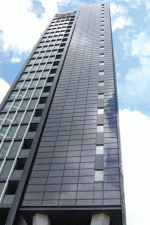
While a completely carbon neutral solution is not yet possible, say the owners of Crowne Plaza Copenhagen Towers, the new luxury hotel in Copenhagen’s Ørestad district comes close to achieving it by deploying the best environmental and energy technology on the market.
Copenhagen’s latest luxury hotel has been designed from the ground upwards with sustainability in mind. From the point of view of energy and the environment, the hotel is several steps ahead of every other hotel in northern Europe. In order for energy consumption and CO2 emissions to be as low as possible, the hotel insisted on state-of-the-art energy technology throughout. One of its most significant features is an innovative ground water cooling system which supplies the heating and air conditioning for 366 guest rooms, conference rooms, kitchen, restaurant and offices in an adjoining wing.
Copenhagen Towers is also equipped with 2,500 specially adapted solar cell panels mounted on three of the hotel’s four facades, which will provide about 15% of the building’s electricity requirements throughout the year. The installation constitutes Denmark’s largest private array of solar cells, producing 200GWh per year – equivalent to the electricity consumption of 65 average-sized detached houses. Both the ground water heating and cooling system and the solar cells are part of the foundation on which the hotel’s green profile rests. To make them as energy-efficient and cost-effective as possible, the systems are equipped with Danfoss VLT frequency converters and TripleLynx solar inverters.
Cooling system
The ground water cooling system required two lots of drilling to a depth of 110 metres at two locations near the hotel. In the summer, cool water from the ground (at 7-9?C) is pumped via one set of wells to the hotel’s cellars where it is sent through a heat exchanger and back down to a heat reservoir where the heat accumulates and is stored during the warmer months. The cooled water from the heat exchanger is circulated in the building to cool rooms to the desired temperature. No active refrigeration is required. The COP (coefficient of performance) can be as high as 40, which means that the cooling effect is 40 times the electricity consumed by the installation.
In winter, water from the reservoir, which has accumulated heat during the summer period, is pumped through the heat exchanger and back down to the wells. Heat from the heat exchanger is sent through two heat pumps which raise the temperature to 55?C. This is then used to heat hotel rooms and offices. “The combination of ground water cooling and heat pumps is an innovative solution as it allows us to recycle heat from the summer months and use it during the cold winter months,” explains Peter Andersen, Property Director for Copenhagen Towers. The installation represents Denmark’s first ground-water based cooling and heating system and will save up to 90% of the hotel’s heating and air conditioning energy consumption.
The two GEA Grenco heat pumps have a combined heat pump performance of 2.4MW and are fitted with frequency converter controlled screw compressors which enable the pumps to adjust the heat capacity continuously from low to full performance, with the same efficiency. Heat pumps do not always run at full capacity and it is therefore important for energy consumption that efficiency is high, irrespective of whether the system is working at full or half capacity. All ground water pumps have VLT frequency converters, and speed control of the pumps that propel heat around the hotel’s internal heating and air conditioning systems is also performed by Danfoss frequency converters. These help to ensure good capacity control and afford superlative energy savings for the pump system.
The solar cell panels mounted on the hotel’s facades are the largest installation of their kind in northern Europe. Each of the Crowne Plaza’s south-facing facades is covered with ultra-thin, high-tech solar cells. Together, these generate around 170,000 kWh per year, roughly 15% of the electricity consumption of the hotel. The hotel buys the remaining 85% in the form of green energy produced by wind turbines from DONG Energy.
Achieving sustainability
Several other initiatives have been used to reduce CO2 emissions as far as possible and to ensure that the hotel achieves its aim of sustainability. For example, VAV (Variable Air Volume) ventilation has been installed in all of the hotel’s rooms. “This means that we can control air volumes electronically in each room, according to need and to occupancy. We also have intelligent lighting in all hotel corridors and low energy lights throughout.” says Andersen.
Another measure is water-saving equipment, including energy and water-efficient dishwashers. Unnecessary products and packaging have also been cut back. Guest rooms have LED flat-screen televisions which at the time of purchase were the most energy efficient. All electronic equipment is computer controlled from reception so that consumption is kept to a minimum when the room is not in use. Fridge temperatures are changed according to the time of day. All components of the hotel’s IT infrastructure – not least PCs and laptops – are selected for their energy characteristics and reusability. It has even been decided to forego the customary hotel information folder. All the information a hotel guest might need is available in electronic and interactive format via the television, presented in a familiar Internet page format.
“Our basic principle is to attain sustainability without compromising quality and visitor comfort. I believe we have managed to achieve both,” says Andersen.
The hotel has been built to the Danish building regulations’ Low Energy Standard, Class 2, which means that it is not allowed to use more than 42.6 kWh of energy per square metre per year. This represents a saving of 53% compared to the current energy frame (2008), of 90.9kWh of energy per square metre per year. Copenhagen Towers also expects a yearly saving of 1,373 tons of CO2.
